Yield
It is a financial measure that quantifies the income generated by an investment within a designated time frame.
What is Yield?
Yield is a financial measure that quantifies the income generated by an investment within a designated time frame. It takes into account dividends, interest, or net income and is calculated based on the investment's initial cost or market value.

It is expressed as a percentage of the investment's initial cost or market value. It takes into account dividends, interest, or net income and is calculated based on the investment's initial cost or market value.
It helps investors understand how much income they can expect to earn annually about their investment's value. It differs from return in that it focuses solely on income generated by the investment, whereas return encompasses both income and capital gains or losses.
Generally speaking, the return for an investment is expressed in dollar terms and covers all profit or loss over a given period. When calculating it, there are different types to consider depending on the valuation of the security. High yield does not always indicate a sound investment.
Securities offering high levels of returns often come with higher risks. Investors need to be careful when considering this metric when making investment decisions.

Monitoring and comparing this concept in the same asset classes or sectors are necessary to provide investors with an accurate understanding of their investment performance and inform them about decisions they should make.
Additionally, it's advisable to consider the risk associated with a higher-yielding investment and conduct thorough research to assess its underlying fundamentals and sustainability.
Considering these additional factors allows investors to gain a more comprehensive understanding of this metric and make more informed investment choices.
This indicator is useful for investors to assess the possible income potential but should be accompanied by other factors to examine an investment's total quality and risk.
Key Takeaways
- Yield is a financial measure that quantifies the income generated by an investment within the designated time frame, providing insights into an investment's income potential.
- It can be classified into different types, such as current yield, dividend yield, yield to maturity, and yield on cost, each focusing on specific aspects of investment returns and helping investors assess different investment opportunities.
- A higher level of Yield generally indicates lower risk and higher income potential for investors, but it's essential to consider other factors beyond just high yields to evaluate investment performance.
- Comparing Yields across different investments can help investors make informed decisions.
Interpretation of Yield
The interpretation of yield provides valuable insights into an investment's income potential and can help investors make informed decisions.

A higher value is generally perceived as an indicator of lower risk and the potential for higher income for investors. This is because a higher return means that investors can recover larger cash flows from their investments.
It proposes that the investment can generate higher income relative to its cost or market value. Investors often seek higher returns as they indicate the possibility of earning more from their investments. However, it is crucial to carefully analyze the calculations involved in determining it.
Sometimes, a high yield may result from a declining market value of the security. This means that the denominator used in the metrics formula, which represents the investment's cost or market value, decreases.
As a result, the calculated value increases even when the security valuations decrease. Investors must consider factors beyond high values when evaluating an investment's performance.
Note
It can be misleading to rely solely on high returns without also taking into account other relevant factors, and it cannot provide a complete understanding of an investment's overall performance.
While many investors focus on dividend payments from stocks, it is equally important to consider the yields associated with those stocks. If they become excessively high, it may indicate potential issues.
A high value could be a sign that the stock price is declining, which can negatively affect overall returns.
Alternatively, it may suggest that the company is paying out high dividends, potentially straining its financial position. Investors should be cautious and investigate the reasons behind its sudden increase.
Increased dividend payments from a company often reflect improved earnings, which can result in higher stock prices. In such cases, one would expect a consistent or marginal rise in the metric, aligning with the stock's overall positive performance.

However, this can indicate that the company has paid dividends without an improvement in profits if corresponding increases in share price do not accompany a significant increase in yields. This might be a warning sign to alert us about the potential for cash flow challenges in the near term.
Hence, this metric serves as a quantifiable benchmark of the tangible return generated by an investment during a specific timeframe. It applies to various bonds and stocks and is presented as a percentage of the security's value.
A higher value is generally seen as a positive indicator of lower risk and higher income potential. However, investors should consider the underlying factors affecting yield and not rely solely on high yields without considering other aspects of the investment's performance.
Monitoring this metric provides important information about the cash flow generated by investment and can aid in assessing its overall profitability.
Factors Affecting Yield
Several factors influence the yield of financial instruments in the market. Some of them are as follows:
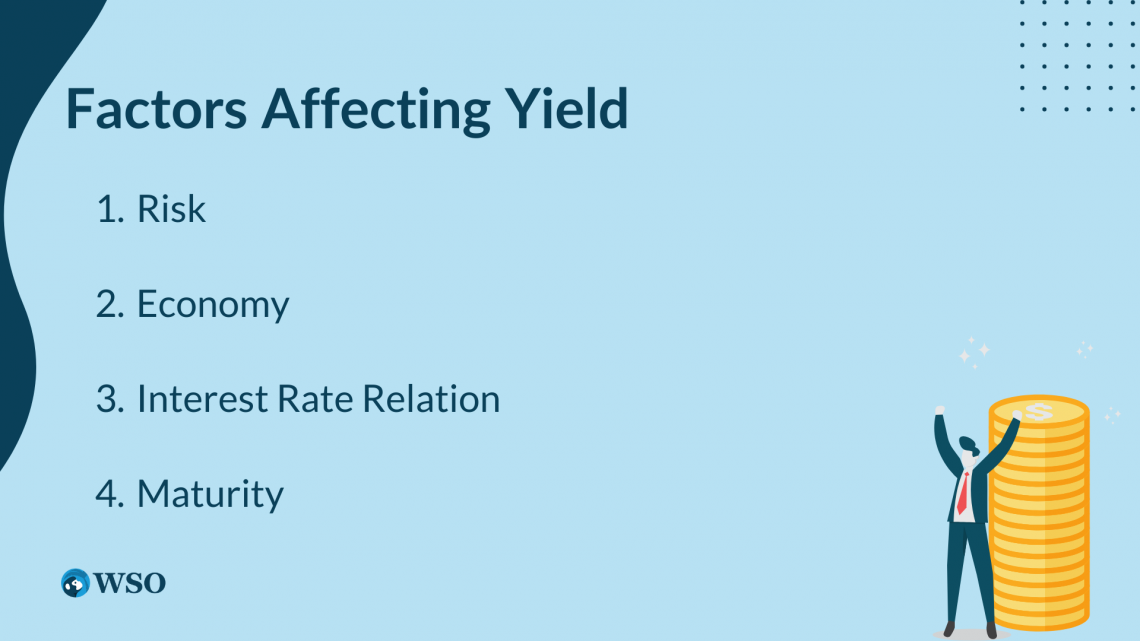
1. Risk
Investor perceptions of risk play a significant role in determining the required yield for a particular security. Investors demand higher levels of returns to compensate for the perceived risk associated with the investment.
Securities with weaker credit ratings typically require higher yields, as investors seek compensation for the increased risk of default on interest payments and principal repayment.
2. Economy
Expectations of inflation and the overall economic outlook impact the metrics levels. Investors will want higher yields to protect their purchasing power if they fear high inflation in the future.
Note
Economic conditions, such as changes in the business cycle, also influence the metric levels.
3. Interest Rate Relation
Interest rates in the Financial Market are inversely correlated with yields on fixed-income securities. When market rates rise, the prices of bonds or notes fall, leading to higher yields to align with market rates.
Note
When market rates decline, bond prices increase, resulting in lower yields, assuming other factors remain constant.
4. Maturity
In normal market circumstances, higher yields are more likely to be obtained by long-term fixed securities compared with short-term securities.
This reflects the higher exposure of long-term securities to uncertainties and potential changes in market interest rates over time. Longer maturity securities are more prone to price volatility, and therefore, investors require higher yields to compensate for this additional risk.
Understanding these factors is crucial for investors in evaluating and comparing investment options. It helps investors assess the risk-return trade-off and make informed decisions based on their risk appetite and market conditions.
Note
The yield curve further illustrates the relationship between yield and maturity, which provides insights into the expected yields at different maturities.
These factors shape the yield environment and impact the market's attractiveness and pricing of various financial instruments.
Yield Definition Formula
This formula is a method for calculating the annual income-only return on investment.

It measures the cash flow an investment generates relative to the amount invested. While it is commonly calculated annually, other variations, such as quarterly or monthly returns, can also be used.
The formula is as follows:
Yield = Net Realized Return / Principal Amount
This, however is the general formula for it, there are many different types of the same, and they are as follows:
Dividend Yield (Stocks)
The following formulas allow investors to assess the potential income return from their stock investments.
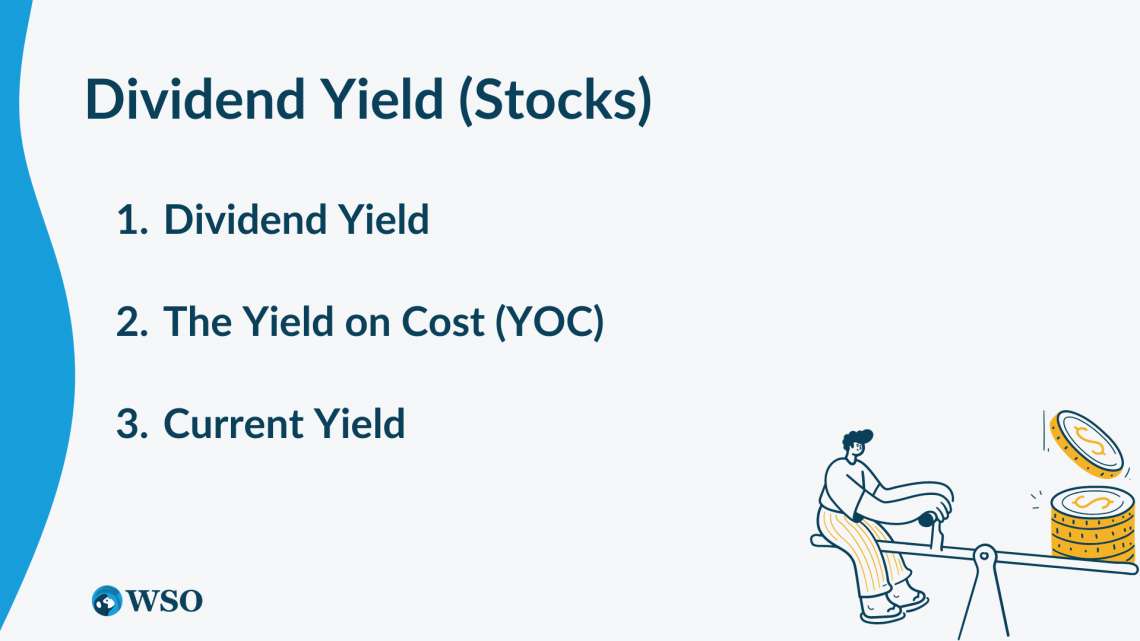
1. Dividend Yield
It is a measure that represents the annual dividend income as a percentage of the stock's current market price. It is calculated using the following formula:
Dividend Yield = (annual dividend per share / current stock price) x 100
2. The Yield on Cost (YOC)
It calculates the return based on the purchase price of the stock. It is determined using the formula:
Yield on Cost = (Price Increase + Dividends Paid) / Purchase Price
3. Current Yield
It calculates the returns based on the current market price of the stock. It is determined using the formula:
Current Yield = (Price Increase + Dividends Paid) / Current Price
Note
The current yield decreases when the stock price increases due to the inverse relationship between yield and stock price.
Interest Yield (Bonds)
These different measures of bond yield help investors assess the income potential and returns from bond investments.
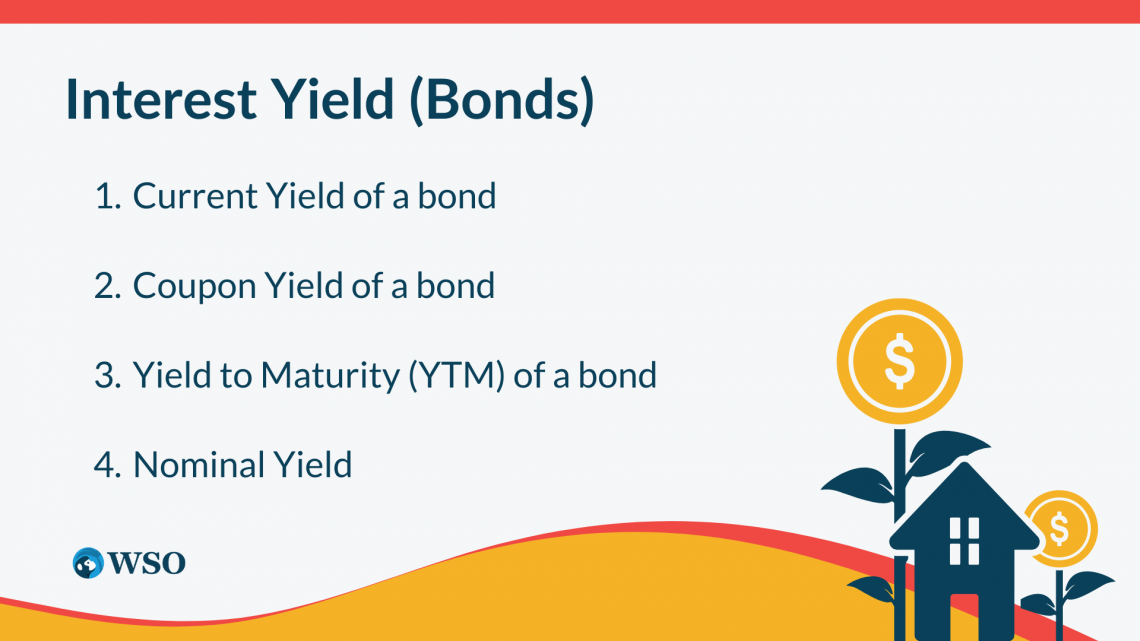
1. Current Yield of a bond
It is calculated by dividing the annual interest payment by the bond's current market price. It represents the income generated by the investment without considering any changes in value.
Current Yield = (Annual Interest Payment / Current Market Price) x 100
2. Coupon Yield of a bond
The annual interest payment is expressed as a percentage of the bond's maturity value. It is established when the bond is issued and remains constant over the bond's life.
Coupon Yield = (Annual Coupon Payment / Maturity Value) x 100
3. Yield to Maturity (YTM) of a bond
It represents the overall return on investment, considering both coupon payments and any capital gain or loss if the bond is held until maturity.
The calculation of YTM is more complex and considers the present value of all expected future cash flows from the bond.
Note
It takes into account the bond's purchase price, coupon payments, and the difference between the purchase price and the face value of the bond.
4. Nominal Yield
It is the return on a bond that pays annual interest and is calculated as the annual interest earned divided by the face value of the bond.
Nominal Yield = (Annual Interest Earned / Face Value of Bond) x 100
Note
The yield calculation for floating interest rate bonds and index-linked bonds can vary based on the terms and conditions of the bond.
Rental Income Yield (Real Estate)
These different measures of rental income yield help real estate investors assess the potential return on their investment and make informed decisions.
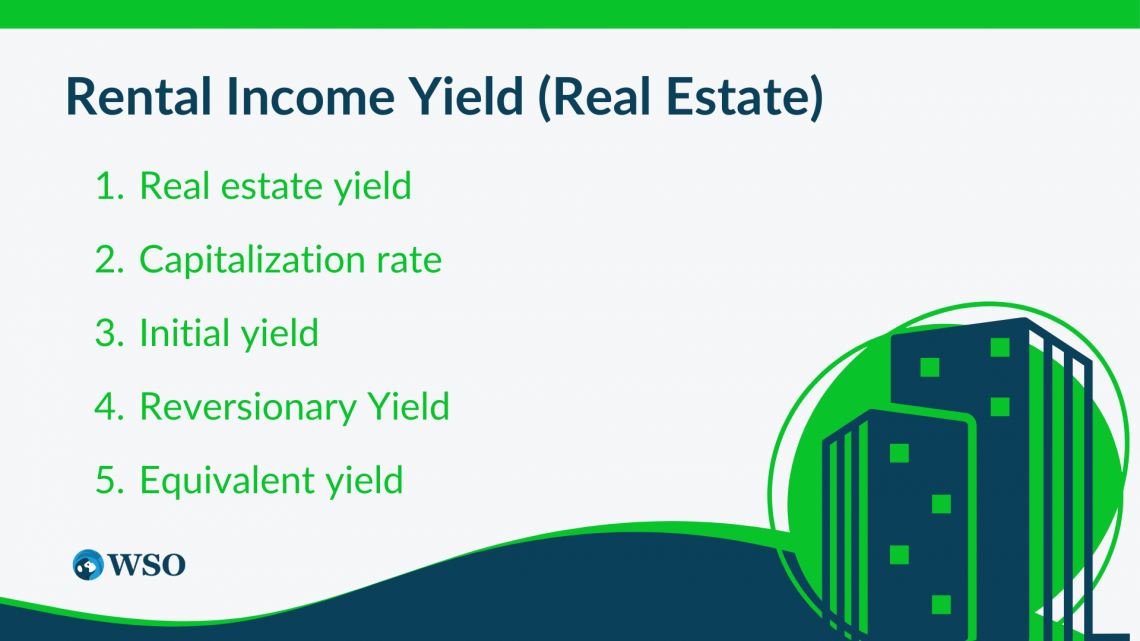
1. Real estate yield
It measures the return on investment from the rental income generated by a property.
Real Estate Yield = (Net Rental Income / Real Estate Value) x 100
The Capitalization rate, or cap rate, is a common measure used in real estate to assess the return on investment from rental income.
Capitalization Rate = (Net Operating Income / Property Value) x 100
3. Initial yield
It is a measure of the annual rental income generated by a property expressed as a percentage of the property's value. It indicates the return at the current rental level.
Initial Yield = (Annual Rent / Property Value) x 100
It represents the anticipated return to which the initial return will rise or fall once the rent reaches the estimated rental value (ERV).
Reversionary Yield = (ERV / Property Value) x 100
5. Equivalent yield
It is a measure that considers the net present value of the property's cash flows, including rent reviews and costs incurred over time. It represents the discount rate that equates the net present value to zero in a discounted cash flow (DCF) analysis.
The calculation of equivalent yield typically involves assumptions and can be determined using trial and error methods or Excel's goal-seek function.
Mutual Fund Yield
This is a measure used to represent the net income return of a mutual fund. It is calculated by dividing the annual income distribution payment by the value of the mutual fund's shares.

This formula returns the income received by the fund through dividends and interest earned by the fund's portfolio during a given year.
Mutual Fund Yield = (Annual dividend/share price) x 100
Other Types of Yields
Here's the information about different types of yields:
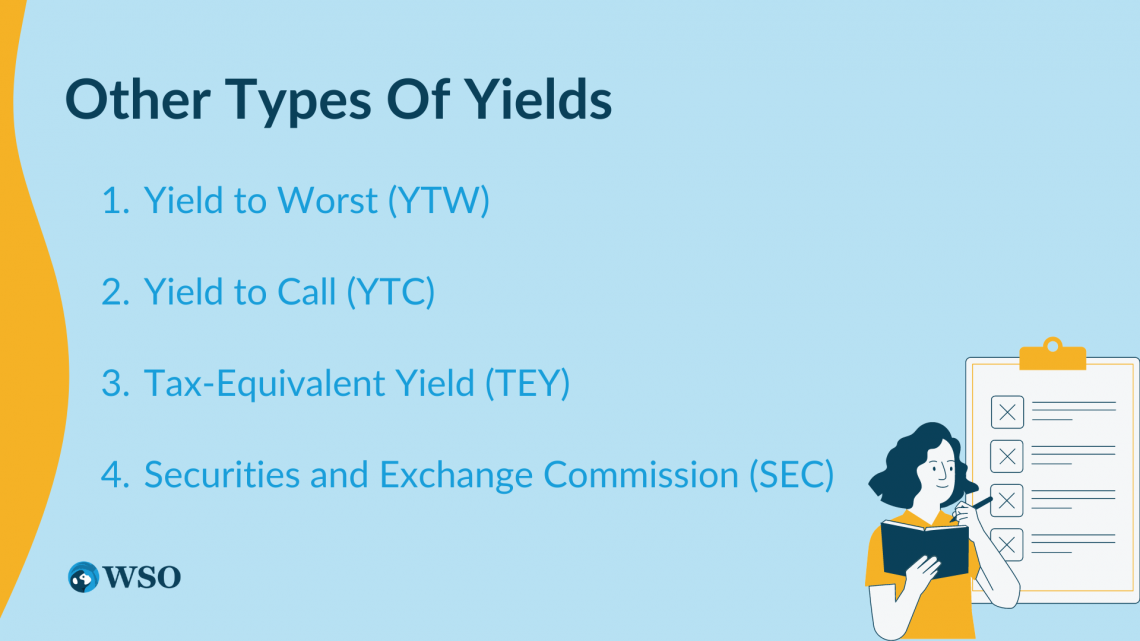
It is the lowest potential return that can be received on a bond without the issuer defaulting. It accounts for potential scenarios where the issuer exercises provisions like prepayments, callback, or sinking funds, resulting in the worst-case yield.
It is specific to callable bonds, which the issuer can redeem before maturity. YTC refers to the bond's return at the time of its call date. It considers the bond's interest payments, market price, and the duration until the call date.
It is relevant for municipal bonds, which are mostly non-taxable. TEY represents the pretax return required by a taxable bond to match the return of a tax-free municipal bond. It depends on the investor's tax bracket.
4. Securities and Exchange Commission (SEC)
It introduced the SEC yield as a standard measure for calculating bond fund returns. It aims to provide a fairer basis for comparing different bond funds.
These consider the required fees associated with the fund.
Note
It's important to note that companies, issuers, and fund managers may have variations in calculating and reporting yield values based on their conventions. However, regulators like the SEC have introduced standards to promote consistency and transparency in the calculation.
Yield FAQs

Whether a high yield is good or not depends on the context and the investor's objectives. Generally, it can be attractive as it signifies a higher return on investment.
However, this can also indicate an increased risk or the potential for losses, and it is appropriate to consider the underlying factors contributing to those yields.
The downside of a high yield is that it often comes with higher risk.
It could be a sign of an investment that is more vulnerable to fluctuations, market uncertainties, or potential default. High-yield investments may also carry liquidity risks, making them harder to sell or convert into cash quickly.
There are various factors, like investor risk tolerance, investment goals, and prevailing market conditions, that determine a good investment yield.
Considering the risk-reward trade-off and comparing the yield with similar investments and benchmarks within the same asset class is essential. A good investment yield depends on the investor's specific circumstances and preferences.
It should strike a balance between generating a satisfactory return and managing risk. Comparing the yield to industry benchmarks and similar investments helps determine whether it is competitive and aligns with market conditions.
It can indeed be negative when the income or return generated by an investment is less than the initial investment, resulting in a loss. Negative yields occur when the return on an investment is below zero.
This can happen in certain bond markets when interest rates are very low or during periods of deflation. It imply that investors are willing to accept a loss in order to preserve capital or seek safe-haven assets.
It differs from total return in that it focuses solely on the income generated by an investment, while total return encompasses both income and capital appreciation or depreciation.
A change in value over time, including both income and capital gains or losses, shall be considered for the total return.
The floating rate bonds, notes, and Treasury Inflation-Protected Securities coupons shall be adjusted periodically upon reference to an established benchmark.
The future dividend stream on these securities cannot be calculated accurately because yield to maturity and internal rate of return are impossible. It is necessary to use other metrics.










or Want to Sign up with your social account?